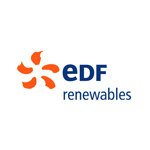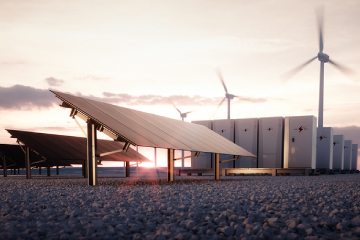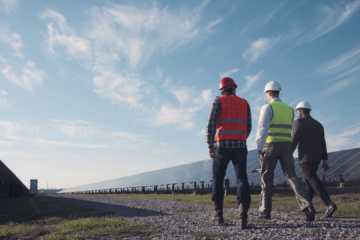- About UsAbout UsWe’re committed to providing future generations with the means to power their lives in the most economic, environmental and socially responsible ways possible.
- What We DoWhat We DoWe are a market-leading, independent power producer and service provider, delivering: wind (onshore and offshore), solar photovoltaic, storage, and electrical vehicle charging.
- Landowners
- Suppliers
- Projects
- Careers
- News
- Contact
Respecting the Land, Respecting Traditions

How EDF Renewables North America builds successful partnerships with Indigenous communities in Canada
By Stephane Desdunes, Senior Director, Development, Grid Scale Power and David Warner, Director, Business Development
Canada is home to more than 630 Indigenous communities, and archaeological evidence shows these communities have lived on land that is now Canada for at least 12,000 years if not longer.
The importance of community and Indigenous partnerships has long been engrained in the Canadian renewable energy industry. Provincial solicitations reinforce this with strong encouragement or requirements that projects embrace their local communities – indigenous or non-indigenous – to bolster social acceptance of the project.
In recognition of this heritage, it is customary that land use discussions involve representatives of Indigenous communities with ancestral ties to the land.
At EDF Renewables North America, we have embraced this practice wholeheartedly. Since 2007, we have taken a proactive and collaborative approach toward engaging both Indigenous and non-Indigenous communities. More than 65% of our Canadian portfolio (1,252 MW out of 1,887 MW total) is composed of projects with community ownership.
Environmental and cultural stewardship are core values that guide how we develop wind and solar projects. These values are part of being a good corporate citizen with sustainable business practices, but they have also proven to be a differentiator for EDFR.
Our commitment to work with local communities extends across Canada and beyond active projects. We have developed relationships with approximately 20 communities in five provinces, and even in instances where our projects don’t have an Indigenous partner, we at times, hire environmental monitors from the local community to be present during the excavation phase of construction to ensure any concerns of the community are integrated and that our work respects the ancestry of the land.
Frequent, transparent communication and respect are the hallmarks of our approach to project development. We meet with local leaders, elders, and the community at large to understand their priorities and concerns, and to incorporate valuable lessons about the local land, history, and impact of development. We provide financial support to ensure the community can access the resources it needs to make informed decisions prior to EDFR making a final investment decision.
Once the footprint of a proposed wind or solar project begins to take shape, we conduct extensive site visits with groups of community members and listen to their stories about their personal connections to the land. This requires a significant investment of time, but the experiences have been amazing. As individuals who grew up in urban environments, these visits have provided a window into the history and culture of the area while rewarding us with some of the most unique experiences we’ve had in our professional lives.
The information gathered through these visits is combined with formal archaeological and cultural surveys to identify sensitive areas for preservation. For us, they always highlight the natural alignment between the sustainability of renewable energy and the values of Indigenous communities, which believe that people should live in balance and harmony with nature by conserving land and protecting the environment.
Above all, Indigenous communities want to be engaged, presented with the potential impacts of our development, listened to, and shown the respect they deserve. These relationships aren’t developed over the phone or email. They’re developed by taking the time to travel to meet community elders in person and talk to them face to face.
Canada’s abundant natural resources aren’t limited to renewable energy, and many communities had engaged in discussions with companies in the forestry, oil and gas or extractive industries prior to our arrival. As a result, they already have relationships with trusted consultants who help them make decisions about financial, legal, environmental, cultural and traditional land use matters. Our financial support helps ensure the community has free prior and informed consent before allowing incremental development on their traditional territory. We welcome and encourage communities to engage consultants who can provide a holistic assessment of the totality of overlapping land use proposals so they can provide us with an informed choice regarding the development they wish in their territory.
Once an Indigenous community has chosen to move forward as our equity partner, they typically establish a special purpose entity (usually an LP) that becomes the equity owner in the project LP. Most communities have economic development officers, and these individuals work to maximize benefits to the community, including capacity development, training, and employment opportunities where feasible.
Canada has set ambitious greenhouse gas emission reduction goals, and renewable energy will play a critical role in helping reach those targets. We look forward to continuing to work with Indigenous communities to deliver a clean energy future to this great country.
Post a Comment Cancel reply
- © 2025 EDF Renewables North America
- Privacy Policy
- AB 1305 Disclosure
- TCFD Report



Comments (3)
Great to hear! Thanks for sharing these details!
Would you possibly share some details about “these visits have provided a window into the history and culture of the area while rewarding us with some of the most unique experiences we’ve had in our professional lives.”
What have you learned? What experiences have you had?
The experiences have been unique and varied. We’ve seen first hand how some Nations have limited access to health care, safe drinking water, jobs and opportunity. We’ve heard first hand the stories of residential school systems and the systemic racism facing these communities. The challenges are not new – these members have witnesses decades of oppression, hindered by an inability to gain wealth (when you don’t own the land where your home sits – it’s hard to gain equity). The remote nature of some communities cuts them off from greater potential to grow and have success.
The projects we’ve proposed or constructed in partnership with the communities represent an opportunity for better health care, access to clean drinking water, scholarships, internships, and the ability to break the cycle of oppression facing these nations.
These investments offer the ability to change a life, a community and a nation. Members participate in environmental studies, traditional land use assessments, archaeological studies, open houses, site tours for Elders, ground blessing ceremonies, construction activities and long term operations.
Their feedback during site assessments is incorporated into overall design – avoiding sensitive areas and providing insight into how the ground changes over time – insight that can be leveraged by contractors during construction.
I hope we have the ability for more partnerships – sharing and giving back on the lands where we do business makes good economic sense and calibrates the moral compass for all those who have the benefit of being involved.